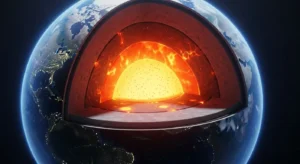For decades, scientists have studied how carbon moves between Earth’s surface and interior in what is called the deep carbon cycle. Traditionally, the focus has been on carbonates, organic sediments, and volcanic outgassing. But new research suggests that the story may be more complex. Recent ab initio molecular dynamics simulations show that under upper mantle conditions, carbon monoxide (CO) can polymerize into abiogenic hydrocarbons—organic compounds formed without biological input. This discovery broadens our understanding of how carbon is stored, transformed, and cycled in Earth’s interior. (arXiv study)
What Are Abiogenic Hydrocarbons?
 Hydrocarbons—chains of hydrogen and carbon—are often associated with fossil fuels and biological origins. Abiogenic hydrocarbons, however, form through chemical reactions independent of life. In deep Earth environments, where extreme heat and pressure prevail, carbon can reorganize into organic molecules purely through physical and chemical processes. Their presence in the mantle could reshape how we account for carbon reservoirs and fluxes within the deep Earth system.
Hydrocarbons—chains of hydrogen and carbon—are often associated with fossil fuels and biological origins. Abiogenic hydrocarbons, however, form through chemical reactions independent of life. In deep Earth environments, where extreme heat and pressure prevail, carbon can reorganize into organic molecules purely through physical and chemical processes. Their presence in the mantle could reshape how we account for carbon reservoirs and fluxes within the deep Earth system.
The New Research Findings
The study modeled conditions at 10–13 gigapascals (GPa) and 1000–1400 Kelvin—similar to those in the upper mantle, hundreds of kilometers beneath the surface. Key findings include:
- CO polymerization: In dry systems, CO molecules linked together to form larger hydrocarbon-rich species without the need for catalysts.
- Water’s role: In aqueous conditions, the reactions still occurred but were moderated. Fewer large hydrocarbons formed when supercritical water was present.
- Stability: Some of the hydrocarbon species were stable under mantle pressures and temperatures, suggesting they could persist as hidden carbon reservoirs.
These results challenge older assumptions that hydrocarbon formation in the mantle was rare or impossible under realistic geologic conditions.
Why This Matters for the Deep Carbon Cycle
The deep carbon cycle is central to Earth’s climate stability over geologic time. It controls the long-term balance between carbon stored in rocks and carbon released to the atmosphere. The discovery of an abiogenic hydrocarbon pathway matters because it could:
- Add previously unrecognized carbon reservoirs to mantle models.
- Provide new sources of carbon flux when hydrocarbons oxidize into CO or CO₂ during migration or metamorphism.
- Explain certain anomalies in volcanic gases or mantle-derived inclusions.
Comparisons with Other Carbon Processes
This new mechanism complements other deep Earth carbon processes already being studied:
- Mantle redox processes control whether subducted carbon is stored as diamond, released as CO₂, or recycled in other ways.
- Carbon leaks from continental rifting show how carbon can escape through non-volcanic pathways.
- Subducted sediments deliver organic and inorganic carbon deep into the mantle, fueling reservoirs that can persist for millions of years.
With abiogenic hydrocarbon synthesis now in the picture, the carbon cycle appears more dynamic and multifaceted than previously imagined.
Potential Impacts on Climate and Surface Budgets
 Earth system and climate models depend on accurate accounting of long-term carbon sources and sinks. If mantle hydrocarbons contribute significantly to carbon fluxes, our estimates of volcanic emissions, degassing, and surface carbon budgets may need adjusting. For example:
Earth system and climate models depend on accurate accounting of long-term carbon sources and sinks. If mantle hydrocarbons contribute significantly to carbon fluxes, our estimates of volcanic emissions, degassing, and surface carbon budgets may need adjusting. For example:
- Additional CO₂ emissions may result when abiogenic hydrocarbons oxidize during ascent.
- Some hydrocarbons might migrate and persist, potentially influencing crustal chemistry or even energy deposits.
- Deep carbon budgets may be underestimating the total mantle carbon reservoir if hydrocarbons are not currently included.
Unanswered Questions and Future Directions
As promising as these findings are, they raise new questions for geoscientists:
- How common are these reactions in natural mantle environments, where minerals and redox conditions vary widely?
- Do hydrocarbons survive transport toward the crust, or are they oxidized before reaching shallower levels?
- Can geochemical fingerprints of abiogenic hydrocarbons be detected in mantle xenoliths or volcanic gases?
- What role do these pathways play in Earth’s long-term carbon and climate regulation?
Why This Discovery Is Significant
The identification of abiogenic hydrocarbons in the upper mantle underscores Earth’s chemical creativity. It shows that even in extreme conditions, complex molecules can form and persist. This is significant not only for geoscience but also for astrobiology—suggesting that similar processes might occur on other rocky planets or moons with high-pressure interiors.
Internal Links for Readers
Conclusion
The discovery of abiogenic hydrocarbons in Earth’s upper mantle is a reminder of how much we still have to learn about the deep carbon cycle. By adding a new pathway for carbon storage and flux, this finding challenges current models and invites more research into mantle chemistry. The implications stretch from climate science to planetary geology, making this a milestone in our understanding of carbon’s hidden journeys beneath our feet.
Deep Earth research continues to reveal that carbon is not only a surface phenomenon—it is a planetary force cycling through layers of Earth in ways we are only beginning to understand.



